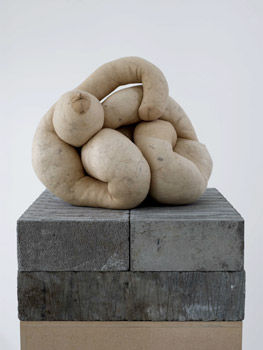Programme Highlights 2012–2013
Henry Moore Institute
The Headrow
Leeds LS1 3AH
www.henry-moore.org/hmi
Facebook
Twitter
The Henry Moore Institute is a centre dedicated to the study of sculpture. Our 2012–2013 exhibition programme features a series of exhibitions that address how the sculpture of today is informed by the histories of sculpture and its surroundings.
John McCracken: ‘IV’ (1985) and ‘Neon’ (1989)
29 February–13 May, Gallery 4
The programme opens with the first in a series of exhibitions presenting sculptures from the past that have made sculpture in the present possible, launching with two works from the 1980s by the American artist John McCracken (1934–2011). McCracken’s sculptures ask a fundamental question: ‘how do things sit in space?’ Condensing the possibilities of sculpture into single obstructive objects, these are handmade to smooth perfection, utilising the basic languages of sculpture: scale, colour, height, width, and breadth.
Michael Dean: Government
12 April–17 June, Galleries 1, 2 and 3
Government, the first British museum exhibition presenting the work of Michael Dean (b. Newcastle 1977), features entirely newly commissioned works. Single, precise words are the starting point for Dean, his sculptures spelling out their own titles in an abstracted typography. Government quotes from and transforms the Institute’s galleries. The floor is covered with a thick wall-to-wall carpet; the door handles replaced with concrete counterparts. Three large cast concrete sculptures are propped against the walls, each made on site, too large to leave the Institute intact. Inviting touch, Dean’s sculptures are either the perfect size to carry or are large, looming, concrete slabs reflecting their surrounding architecture. Tactility is an essential sculptural quality for Dean—he wishes us to first ‘touch with the eyes, and then allow ourselves to touch with the hand’.
Phyllida Barlow: Bad Copies
12 April–17 June, Sculpture Study Galleries
An artist and teacher who constantly questions the possibilities of sculpture by capturing a sense of the ‘now’, Phyllida Barlow (b. Newcastle 1944) is known primarily for her large-scale installations made from salvaged materials that are constructed on-site. This selection of drawings spans the 1960s to the present. Describing them as ‘bad copies’, Barlow’s drawings are derived from her environment, filtered through memory and reconfigured in the light of her own sculptural concerns.
Vlassis Caniaris: Composition (1974)
30 May–1 September, Gallery 4
From the late 1950s Vlassis Caniaris (1928–2011) made use of materials ready at hand, deploying colour and surface to make human-scale sculptures from makeshift and abandoned objects. From the 1960s he began to create resourceful, caustic compositions made from objects and materials bearing the traces of use, such as wire netting, plaster, clothes, artificial flowers, cardboard boxes, newspaper clippings and suitcases. This display presents a single work, ‘Composition’. A pair of yellow legs stand on a white stool, both feet wearing buckled grey shoes; the legs are a pair of tights, shaped to stand tall, albeit rather misshapen.
Sarah Lucas: Ordinary Things
19 July–21 October, Galleries 1, 2 and 3
Ordinary Things explores Sarah Lucas‘ (b. London 1962) consistent questioning of the definition of sculpture, in a selection of works made from 1993 to the present day. From ‘Big Fat Anarchic Spider’ (1993) to ‘NUDS’ (2009–11), via ‘Bunny’ (1994) and ‘Penetralia’ (2008), this exhibition takes a journey across the conflicting currencies of sculpture the artist has employed over the last three decades. Lucas’ sculptures are physical, formal objects produced through the languages that surround them—be that sculptural, historical or vernacular. Cutting, welding, moulding, handling, stuffing, assembling; monumental, ready-made, formal, quick-build, bombastic, representational, abstract, true-to-materials. Each of Lucas’ sculptures confidently asserts itself, pulling and pushing all that visually surrounds it for its own ends. Each work is economical and complete.
Sturtevant: Duchamp Bicycle Wheel (1969–1973)
26 September 2012–13 January 2013, Gallery 4
Through the subversive approach of repetition, Sturtevant (b. Lakewood 1930) divorces an artwork from its visual image to investigate its conceptual meaning and value to ask ‘what makes this art work relevant today?’ Duchamp made his ‘Bicycle Wheel’ in 1913; Sturtevant’s re-assesses how we look at, remember and endow this first readymade with meaning. Examining understandings of aesthetics, challenging and redefining notions of authorship, the original and the copy, Sturtevant contests the mythologised aura of the original.
1913: The Shape of Time
22 November 2012–17 February 2013, Galleries 1, 2 and 3
1913: The Shape of Time focuses on the production of sculpture in Europe in the year before the First World War. 1913 saw the spread of conflicting avant-garde theories and practices across Europe. This was the year of Luigi Russolo’s first experiments with sound; of Marcel Duchamp’s ‘Bicycle Wheel’; Guillaume Apollinaire’s Cubist Painters; Raymond Roussel’s Locus Solus; Sergei Diaghilev and the Ballet Russes’ Rite of Spring and Roger Fry’s Omega Workshops. It saw Cubism arriving in Moscow and the Armory Show opening in New York. 1913: The Shape of Time examines a variety of sculptural registers, asking how the precarious and anxious predicament of culture in that auspicious year might resonate in our own time.
*Image above:
Copyright the artist, courtesy Sadie Coles HQ, London.

